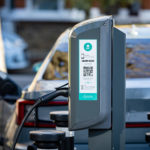Neil Isaacson, CEO of public charge point operator (CPO), Liberty Charge, provides six top tips on how local authorities can deploy charge points at pace and at scale, and deliver a UK-wide publicly accessible EV charging infrastructure network.
As more and more local authorities address the urgent need to accelerate the EV infrastructure roll out, clarity and straightforward objective advice on how to plan, implement and maintain a local EV charging network is in short supply. Supporting local authorities is essential if the Government’s ambition to install 300,000 charge points by 2030 is to be met, when the sale of new petrol and diesel vehicles will cease.
Top tips for rolling out EV charging infrastructure
1. Raise awareness of benefits to residents
Members of the public who don’t yet own an EV, don’t tend to want charging infrastructure outside their homes. They don’t want what they don’t yet know they will need, and without positive reinforcement of the benefits that the EV charging rollout will bring, resident push back is likely to remain.
Local authorities should and do use public consultations to promote the benefits of the EV charging rollout, such as reduced noise and air pollution. However, some local authorities lack budgets and resources to create the necessary hard-hitting campaigns. Local businesses can help by electrifying their fleets and providing at-work charging. But the shift in attitudes in favour of owning and maintaining an EV should sit with national Government.
Indeed, in our soon-to-be-released Local Authority Insight Report, ‘Transforming the delivery of local charging networks across the UK’, many Councillors echoed this sentiment, believing that more support was required from Government to shift driver attitudes away from polluting petrol and diesel vehicles.
2. Understand the timescales
While 2030 is more than seven years away, creating the necessary policies and strategies, undertaking the required due diligence, conducting public consultations, and charge point build and deployment can take 12 months and sometimes as long as three years.
And 2030 is not the deadline. We need infrastructure to be in place to instil consumer confidence to make the switch. We also need to accommodate the growing demands for charging from the increased volume of EVs. When looking at timescales of years not months, the time has to be now to change that.
3. Use data to identify the right locations
It can be challenging for local authorities to identify and prioritise public charge point locations, often with an incomplete picture of local demand to work from. While the current needs and wants of residents is important, taking an objective, scientific approach that also considers the future adoption of EVs and anticipates demand, will ensure supply meets both immediate and future requirements.
Liberty Charge has a proprietary data-led solution which provides insights on which residents will be reliant on on-street charging, as well as logistical data on pavement width, planning regulations and power supply, to inform local authorities of the number and the exact on-street location of charge points required.
4. Attract private sector funding
There is growing appetite from the private sector to invest in EV infrastructure. However, some sites continue to present challenges, often due to high installation costs or lower forecast levels of demand.
Given the significant growth in the number of public chargers required over the coming years, and the limited amount of public funding available, a key role for Councils will be to ensure they attract sufficient levels of private funding to deliver this vital infrastructure.
In order to do this, local authorities will need to make sure what they bring to market is commercially viable, for example with sufficiently long contracts for CPOs to be able to recover their investment. An effective approach to achieving this is for the local authority to offer a portfolio of sites to the market as a concession contract, including a combination of sites with mixed commercial viability.
5. Avoid exclusivity clauses
Exclusivity clauses are obviously beneficial to the winning CPO, but rarely a good thing for residents or local authorities. While they may offer some short-term contractual benefits, the trade-off is less competition in a local area, which in typical market conditions often results in higher tariff costs and a poorer service. Lack of competition is also less likely to incentivise CPOs to compete to achieve better reliability when maintaining and future-proofing the local network.
If exclusivity clauses are agreed, then there should be provision in the contract for local authorities to introduce an additional supplier if the original supplier falls short of a stated uptime of at least 95%. It will be this risk that keeps CPOs that were awarded exclusivity focused on on-going delivery.
6. Carefully assess a CPO’s credentials
As the marketplace matures and the private sector takes on a greater role in delivering much needed EV infrastructure, public-private partnership contracts are likely to be long-term: 15 years. Due diligence is essential to ensure partners are capable of meeting the needs of their residents. Asking the right questions in a tender process is only the start; it’s about creating partnerships built on trust.
We strongly advise that local authorities scrutinise investors, funding, business plans and supply chains of potential suppliers and speak to existing customers to learn first-hand how they have performed, and how easy they are to work with. All credible suppliers should be willing to provide you with at least three contacts.
Visit the local authority EV Infrastructure Hub to access further advice.
Header image shows a charge point on Malvern Road in Waltham Forest.









